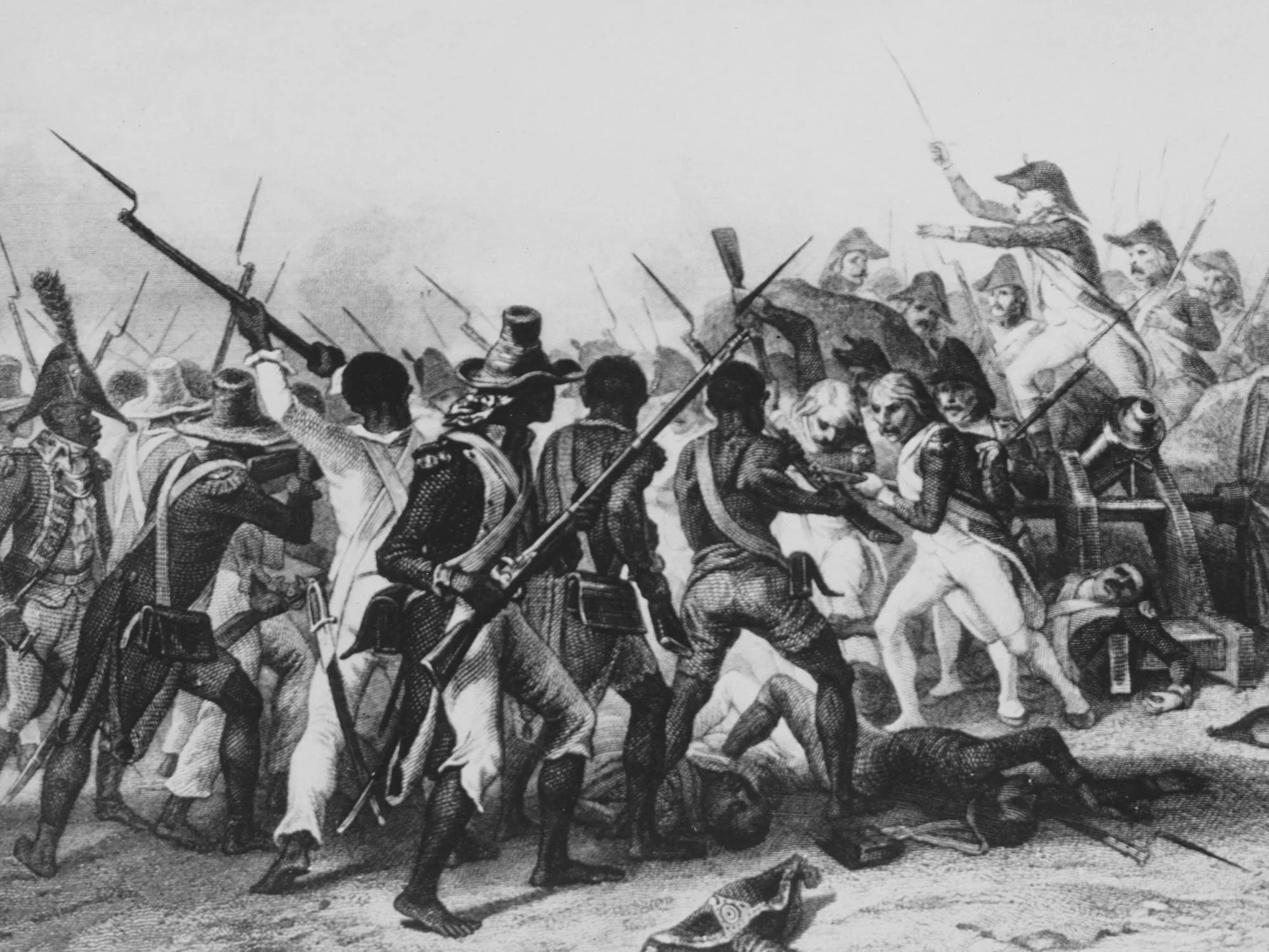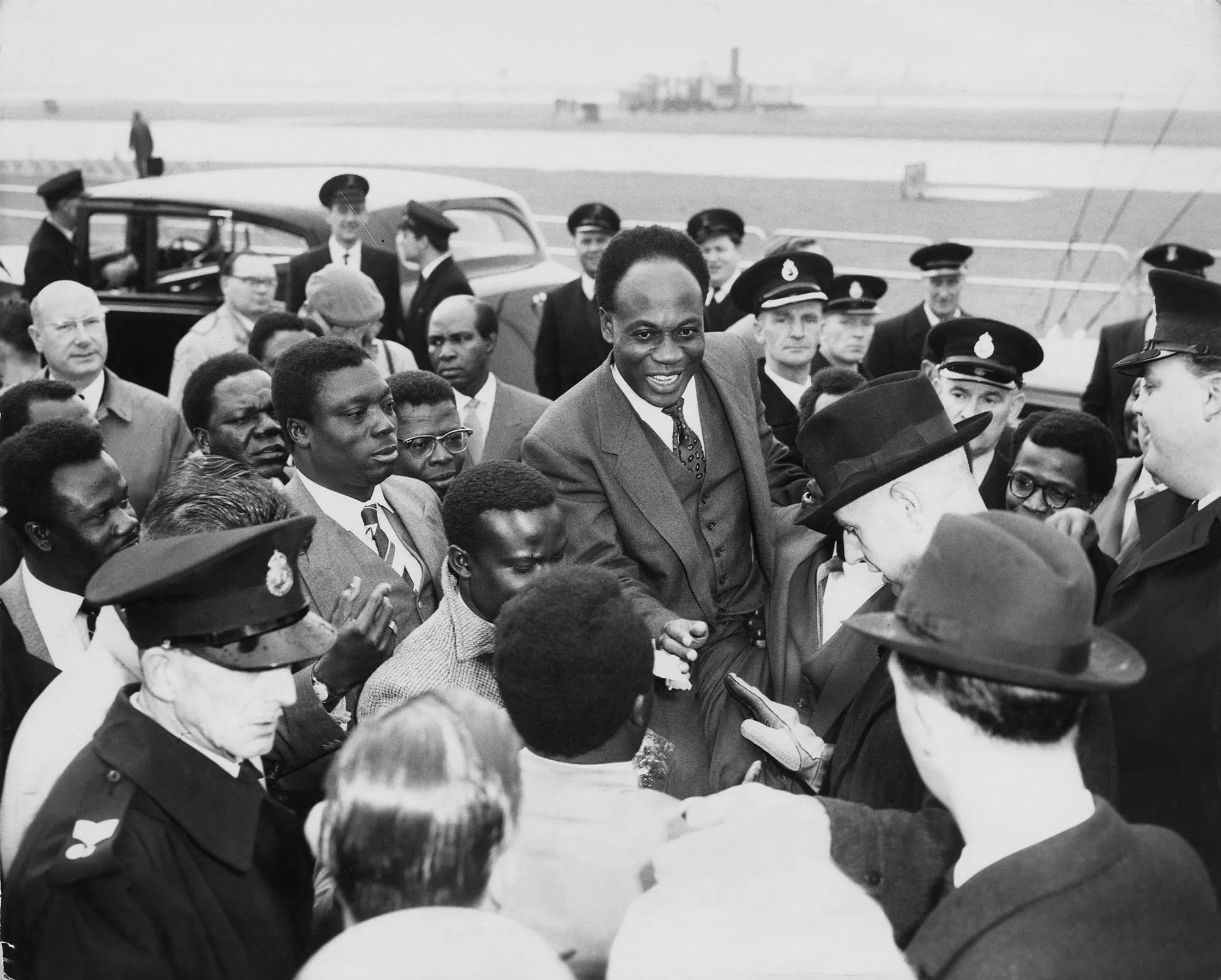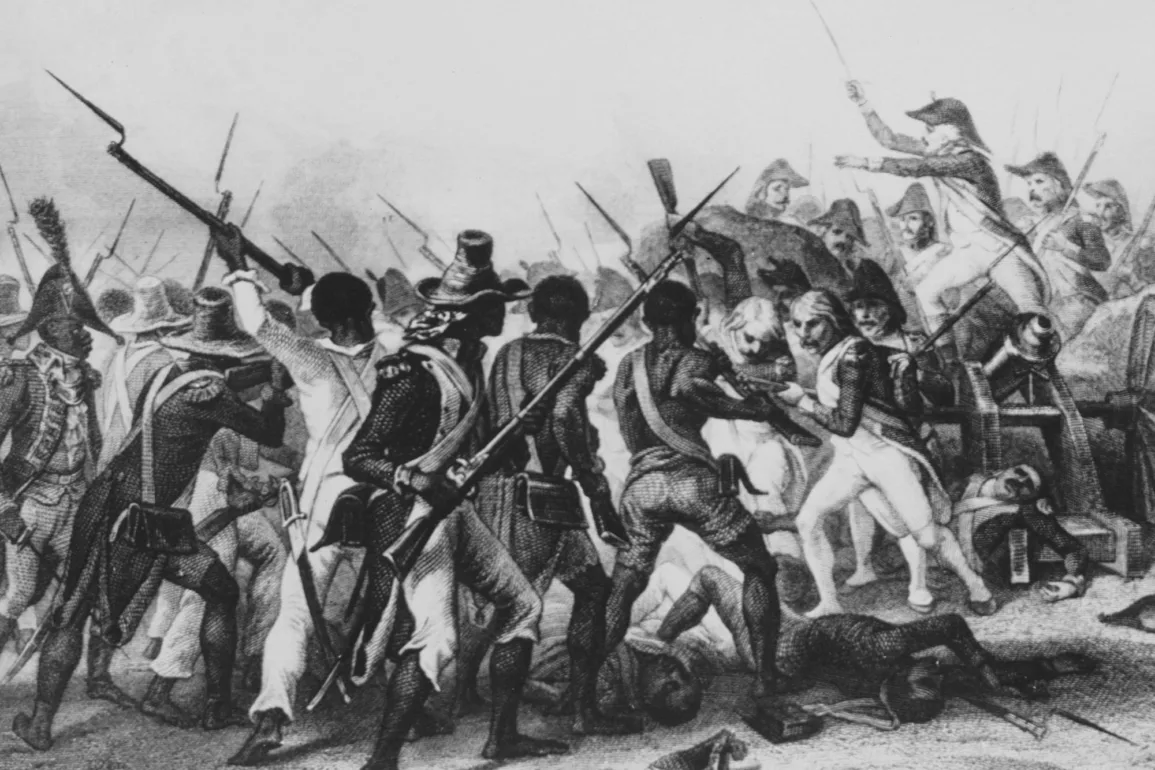A Black Republic doesn’t have to be in Africa; I trace their pre-history to the Americas, to the Quilombo or Maroons, established at the height of slavery in the Atlantic world, between the 16th and 18th centuries, by runaway slaves. Some of them survived for decades and others even for over a century. They were the Promised Land where slaves would self-govern and be free, sovereign, independent, self-reliant, and prosperous.
The Haitian Revolution of 1804, when slaves toppled their masters, was a turning point, in that it brought into being the first Black Republic in a proper sense. Haiti would occupy the centre stage of Pan-African mobilisation again in the 20th century, during the 20 years of its occupation by the US, between 1925 and 1934.

Engraving depicting the Battle of Crete-a-Pierrot of the Haitian Revolution, an insurrection by self-liberated enslaved people against French colonial rule in Saint-Domingue, a French colony in Haiti, at the Crete-a-Pierrot fort in Haiti, March 1802. (Photo: Three Lions / Hulton Archive / Getty Images)
This Caribbean island became a key milestone in the development of pan-African consciousness because the 1804 revolution itself had a shock effect on the slave system, which was a dominant mode of production in the Atlantic world.
At first, the great powers of the time refused to recognise Haiti’s independence, and only did so decades later because of pan-African pressure. Black sovereignty was at the heart of the Haiti project as articulated in the 1804 Declaration of Independence. The African-American abolitionist Frederick Douglass reminded us in his 1893 lecture on Haiti, “When they [Haitian slaves] struck for freedom… they struck for the freedom of every black man in the world.”
Liberia was the next stage in this quest for a Black Republic. Established by the American Colonization Society in the 1820s on the West African coast, it achieved its iconic status for its role as a haven for freed slaves and attracted African-American emigrationists of the 19th century like Alexander Crummell, Henry McNeal Turner and Martin Delany who were leading champions of the “regeneration of Africa” — a concept made popular in South Africa by Pixley ka Seme.
They advocated a paternalistic form of regeneration wherein the African diaspora would colonise parts of Africa as superior blacks on a Christian mission to civilise native Africans. Delany, who was less enthusiastic about Liberia than Crummell, undertook a trip to Africa in 1859-60 whose purpose was to find land, his own Black Republic, to establish an African-American settler colony of his own, for regeneration purposes. He found this piece of land in modern-day Nigeria, but his project could not take off.
The two men may have differed on Liberia, but they agreed on two points: that this regeneration was imminent, and that a Black Republic of a regenerating Africa should be sovereign, self-reliant, competitive and endowed with infrastructure and a thriving economic base. This is in contrast to the type of states that would emerge in post-colonial Africa, from the 1960s.
Both Crummell and Delany were optimistic from the 1850s to the 1860s, as slavery was in retreat. When ka Seme delivered his famous “The Regeneration of Africa” lecture in 1906, he was just following on the path already paved by Crummell and Delany. But the end of slavery did not result in a regenerated Africa; instead, direct colonial control of Africa by Europeans became the new game in town. At the end of the “scramble for Africa”, only Ethiopia and Liberia remained independent.
Ethiopia’s sacred stature
Ethiopia was seen as another candidate for a Black Republic at the same time that Haiti and Liberia were trying to prove their credentials. Yet the source for its status was not from chattel slavery but biblical reference to this ancient country, especially in Psalm 68:31 — “Princes shall come forth out of Egypt; Ethiopia shall soon stretch forth her hands unto God.”
Circumstances of history reinforced Ethiopia’s sacred stature further when the country survived the “scramble for Africa” by defeating the Italians at the battle of Adwa in 1896.
“Having defeated in 1896 the 14,000-strong Italian colonial expedition at the battle of Adwa, Ethiopia emerged as the living embodiment of Africa’s past greatness”, wrote Fikru Gebrekidan. “The Adowa campaign gave [Emperor] Menelik II considerable international prestige,” according to MB Akpan et al.
Ethiopia became a rallying point again when it was invaded by Italy in 1935-37, an event which galvanised global African mobilisation. “When Ethiopia fell under the fascist rule of Benito Mussolini”, said Shawn Sobers, “black activists worldwide rallied around the throne of Ethiopia’s Emperor Haile Selassie.”
The Black Republic theme featured prominently at the six historic Pan-African congresses that took place between 1900 and 1945 in the US and Europe. Citizens of the three republics — Haiti, Liberia and Ethiopia — were always in attendance and active in the deliberations.
In its “Address to the Nations of the World”, the 1900 gathering declared: “Let the nations of the World respect the integrity and independence of the free Negro States of Abyssinia [Ethiopia], Liberia, Haiti.”
The London Manifesto of the 1921 congress added its voice: “The independence of Abyssinia, Liberia, Haiti and San Domingo is absolutely necessary”, and: “The attempts at autonomous government in Haiti and Liberia are not proofs of the impossibility of self-government among black men.”
Similarly, the 1927 congress, convened against the backdrop of the US occupation of Haiti, wrote in bold capital letters “FREE HAITI” and reaffirmed “ABYSSINIA AND LIBERIA”. The 1945 congress occurred when Italy’s invasion of Ethiopia was still a current affair, and sent “its warmest greetings to the Emperor and peoples of Ethiopia, one of the three free states in the world that are controlled by African people. It pledges itself to guard with jealousy the interests of Ethiopia.”
Even Marcus Garvey, the man who established the biggest, global, black nationalist movement in the 1920s, tried to launch his abortive “Back to Africa” venture from Liberia.
The communist movement
The Black Republic also played itself out among black radicals in the communist movement of the 1920s, and influenced the direction of the South African Communist Party (SACP) and the Communist Party of the USA (CPUSA) on the controversial subject of the “national question”. Both parties began with a primarily white membership and struggled with attracting blacks to their ranks.
Diasporic Africans were inspired by the Bolshevik revolution of 1917, but were neither enthusiastic over Garveyism, with its fundamentalist ideas on race, nor impressed by the conservativism of the pan-African movement of the time. They then tried to cultivate a third way, which led some of them to the meetings of the Comintern, the Communist International founded in 1919.
The SACP, formed in 1921, found a consensus already in existence within the Comintern on two areas:
- That the “black question” is global, and therefore the colonial question in Africa and the “negro question” in the US are intertwined and directly linked to the struggle against capitalism and imperialism; and
- That African-American members in the Comintern will take the lead on the “negro question”.
So, when leaders of the newly formed SACP entered Comintern meetings and tried to take the floor on the South African question which unavoidably included colonial oppression, they were met by a hostile reception from two leading African-American participants (Harry Haywood and Claude McKay) who were already respected regulars at meetings of the Comintern.
It is known that in 1928, the Comintern changed the course of the history of the SACP when it directed this party to strive for “an independent native South African republic”. What is less known is that the same Comintern congress that prompted this directive also adopted a resolution on the “negro question” in the US, which characterised African-Americans there as “a nation within a nation” who should struggle for the right to self-determination, and introduced the term “the Black Belt”, defined later, in 1930, as an independent, African-American republic to be established in the southern part of the US.
The debate on “the Black Belt” would continue in the CPUSA into the 1940s over three things:
- Whether African-Americans were a “nation within a nation” in the US;
- Whether the solution was in pursuing their right to self-determination or simply to fight for equal rights and assimilation in the US; and
- Over the “Black Belt” as a Black Republic — whether it was feasible and desirable.
Kwame Nkrumah’s Ghana
The independence of Kwame Nkrumah’s Ghana in 1957 became the next milestone. Nkrumah was immersed in the Black Republic. His 10-year stay in the US had inducted him into African-American politics and thought, not to mention his involvement with organising the 1945 pan-African congress.

Kwame Nkrumah (1909-1972), the Prime Minister of Ghana, arrives at London Airport for the Commonwealth Prime Ministers’ Conference which opened two days later, 1 May 1960. (Photo: Central Press / Hulton Archive / Getty Images)
He was mentored by two Caribbean giants, CLR James and George Padmore, who acted as his close advisers once he assumed the presidency of Ghana. Padmore even became his de facto foreign minister. But Nkrumah took the Black Republic project a step higher when he positioned Ghana as the centre and hub for pan-Africanism. It was thanks to his efforts and ideas that the Organisation of African Unity (OAU) came into being in 1963.
The rise of Nkrumah’s Ghana as a pre-eminent Black Republic was at the expense of Liberia, partly due to the political conservativism of the then Liberian president, William Tubman, and his negative attitude towards continental unity.
Monrovia, Liberia’s capital, became a label for a group of African leaders who were opposed to Nkrumah-type African unity. Domestic politics within Liberia was another factor due to a segregationist system that privileged African-American settlers at the expense of the so-called indigenous Liberians. Ethiopia’s star also dwindled, except for the consolation that Addis Ababa was chosen as the headquarters of the OAU.
With the OAU now in existence, a two-tier Black Republic model emerged. Nkrumah had hoped for a one-tier model with Africa becoming a federation à la the United States of Africa. But this did not happen. Sovereign states emerged with their flags and national anthems, and stood their ground against the drive for the United States of Africa.
In the 1970s, the United Nations Economic Commission for Africa (Uneca) introduced “regional integration”, meaning creating sub-integration entities at a sub-regional level. Rightly so, we give credit for this push to the Nigerian professor Adebayo Adedeji. But it was actually his Ghanaian predecessor at Uneca, Robert Gardiner, who planted the seeds.
When Adedeji joined the Uneca in 1975, he took this effort to a higher level and initiated something new — the drive to establish an African Economic Community. The objectives and steps for realising this goal are set out in two development plans associated with Adedeji — the Lagos Plan of Action of 1980 and the Abuja Treaty of 1991. Both documents, especially the Abuja Treaty, contain an integration roadmap beginning with economic integration and culminating in a political union.
When African leaders interrogated the Abuja Treaty’s roadmap, and at the behest of the late Muammar Gaddafi, they changed their minds and insisted that establishing a political union should happen now, not somewhere in the distant future. Thus at Sirte, Libya, in 1999, the process was set in motion to create an African Union (AU) which was inaugurated in South Africa in 2002.
With the introduction of regional economic communities (RECs) by Uneca in the 1970s, we now have a three-tier Black Republic model — nation-states are the foundation and legs, the RECs are the building blocs, and the AU is the road to the ultimate, to the United States of Africa.
The four republics have held on to their sovereignty even though it was not easy, but three would succumb to internal pressure — Ghana, due to a coup in 1966 that ended Nkrumah’s presidency; Ethiopia, to a revolution in 1974; and in Liberia, a civil war erupted in 1980. Haiti’s story is of perpetual political instability, coups, and political assassinations.
Opportunity for South Africa
When South Africa got its freedom in 1994, the stars were aligned for it to take the position of a Black Republic, to succeed where Haiti, Liberia, Ethiopia and Ghana had failed. The end of apartheid heralded the end of the decolonisation period in Africa, the beginning of a new era.
Kudos should go to Nelson Mandela as our first democratic president. But it was actually Thabo Mbeki who made an attempt to turn South Africa into a Black Republic. His African Renaissance galvanised Africans on the continent and their relatives in the diaspora. He understood the Black Republic connection, and earnestly began reaching out to the African diaspora, even organising a conference in Jamaica in 2003.
“The victory of the African slaves in Haiti in 1804 is directly linked to the victory of the African oppressed in South Africa in 1994,” he reminded us in 2003, like Douglass did more than a century earlier. At Haiti’s bicentennial celebration in 2004, he was mocked by the media for being the only foreign head of state in attendance, and as he drove through the streets of Port au Prince, an agitated mob pelted him with stones.
It’s too early to tell if South Africa has turned its back away from the path to the Black Republic. One thing that refuses to go away is the debate that has been making the rounds since the early days of Haiti, about black self-governance; that blacks are inherently incapable of running a state, and that, therefore, they need supervision by a slave-owner or a colonial master.
For the record though, Ghana and Liberia have since recovered. Ethiopia’s recent civil war is now over. Haiti is still in the news for the wrong reasons. In South Africa, Chief Justice Raymond Zondo has just complained that our Parliament was not doing enough to implement his State Capture recommendations. The ANC is talking about “renewal”, whose results are yet to be visible to the naked eye.
But how far are we from the Black Republic? The three-tier model has produced unintended results. States have become too sovereign to the detriment of the integration project. Each of the RECs is autonomous from the AU, with its own treaty, flag, and anthem. The AU is not adequately empowered — legally, to play a supranational role, and financially, to drive the integration agenda, especially in the domain of infrastructure.
Compared to Mbeki’s time, today’s African integration is in a period of austerity and minimalist in its ambition. The sovereignty index of all African countries is among the lowest in the world. Our self-reliance and prospects for prosperity are still taking a steep curve. The coups that are returning to our continent are our measure of how much work we must still do to dispel racist stereotypes about black self-governance.
We still have more than 70 years left in this century to establish a true Black Republic that Haiti still refuses to become. DM
Eddy Maloka is a professor of practice at the Institute for Pan-African Thought and Conversation, University of Johannesburg. He writes in his personal capacity. This is an abridged version of his lecture “From Haiti to the African Union: The Idea of a Black Republic in Pan-African Political Thought” at the Keith Gottschalk Lecture on African Integration, at the University of the Western Cape on 27 July.



